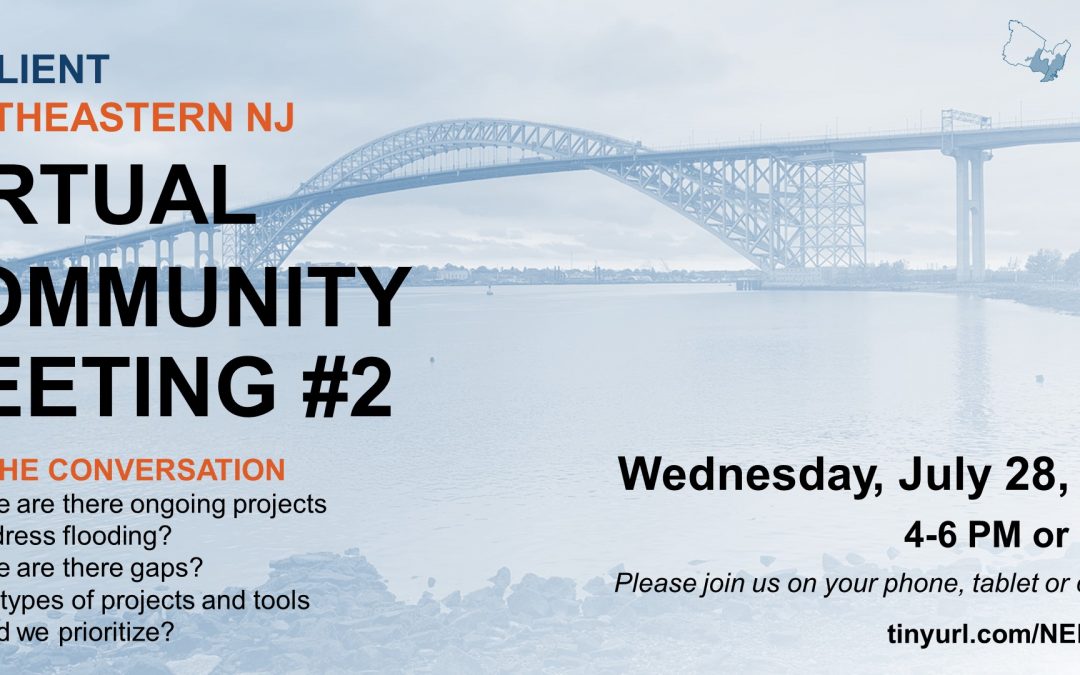Community Meeting #2 was held on July 28, 2021 to advance the regional resilience action plan to reduce flood risks in Jersey City, Newark, Hoboken, and Bayonne. During the meeting, community members joined breakout sessions by city to:
- Discuss flood data and how they reflect lived flood experiences
- Identify gaps and opportunities associated with ongoing resilience projects and initiatives
- Walk-through the resilience planning process for an exploration area to provide input on resilience goals and important constraints and considerations
Two virtual meeting times were offered (4-6 PM and 6-8 PM), and both meetings included live American Sign Language and Spanish interpretation.
WHAT DID WE HEAR?
All the feedback that we received at Community Meeting #2 is compiled in this virtual board. We invite you to explore the board and add your feedback! Instructions for adding comments are at the top of the board.
Here’s a summary of what we heard, by topic. If you feel that we’ve missed anything or got something wrong, we encourage you to let us know by emailing ResilientNENJ@dep.nj.gov or calling 201-275-0861.
We heard many stories about the impacts of flooding and personal resilience. Read about these experiences in our virtual board.
What are the most important things for Resilient Northeastern NJ to accomplish?
- Although climate change is expected to make flooding more common, flooding already is a serious problem across the region now. We heard that this project should include recommendations for immediate and intermediate actions that can efficiently reduce flood risks in the near term. Participants expressed that the project should aim to advance low hanging fruits that can be implemented quickly, while at the same time shifting towards proactive actions rather than reactive.
- While flooding is a major issue in the region, it is not the only problem. We heard that this project should aim to make recommendations that improve overall quality of life while addressing flooding. These improvements could include increasing green and open space (this was a resounding theme), reducing trash accumulation, reducing pollution, improving air quality, addressing urban heat island effect, and adding ecological benefits.
- Occurrences of flooding seem to be happening more frequently and in unexpected places, impacting more people. Educating vulnerable populations, like those in senior and public housing, about risks and individual actions they can take to improve resilience is an important outcome of this project for many participants. Education and information sharing should target different groups, including youth, through a variety of channels and media.
What are gaps and opportunities in the ongoing resilience work at the local, regional, state, and federal levels?
- Ongoing resilient work in the region and state has largely been conducted at the individual agency or municipality level. This project is an opportunity to bring multiple stakeholders in the room to coordinate efforts and improve consistency in approaches.
- The Long-Term Control Plans required for combined sewer system utilities outline major capital projects that will be implemented in the coming decades. We heard that flood mitigation and other quality of life co-benefits should be incorporated into these projects for efficiency and to support a “dig once” approach to coordinate infrastructure projects with different goals.
- There are numerous sources of information for flood data from local and state entities. Participants expressed that there is an opportunity to develop a single source, or “ground truth,” for flood data and information to reduce confusion, to standardize resilience planning processes, and to incorporate real-time data and lived experiences.
What is the story we are getting from flood data and our experiences with flooding?
- Frequent flooding from rain events is the most prominent type of flood hazard experienced in the region. Some participants expressed that the flooding is largely related to overwhelmed combined sewer systems, which were not designed for the levels of intense rainfall that are common today. Participants shared that street flooding is exacerbated by trash that clogs catch basins, preventing water from entering drainage systems, and by continuously increasing impervious cover. Basement flooding is also a widespread issue in the region, but there is less data available on this type of flooding.
- We heard about some experiences of flooding during Community Meeting #1, and we heard additional stories during this meeting. Recent flooding in July created up to several feet of street flooding, stranded buses and cars, and flooded ground floors of homes. We also heard about the economic impacts of flooding because people stay in their homes when it rains, and concerns about long-term economic degradation resulting from increased frequency of flooding.
MISSED THE MEETINGS, OR WANT TO SHARE ADDITIONAL FEEDBACK?
Please visit our virtual board and add your own thoughts. Instructions for adding comments are at the top of the board.
You can also check-out the meeting materials linked below.
View the presentation slide deck here
Recordings
Introductory Presentation
Presentación Introductoria
Maps
Flood maps
Redevelopment areas and ongoing resilience projects
Exploration areas
Jersey City
Newark
Hoboken
Bayonne
Attended the meeting and have thoughts on how it went?
Take our meeting survey here.

